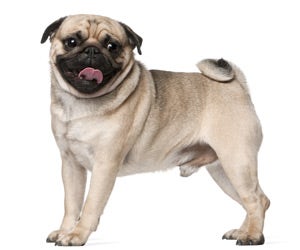Pug
-
Overview
Pugs are unintentional comedians who make excellent companions for apartment dwellers. Although they are known for their inviting pouts, these are cheerful dogs who love to please. Pugs enjoy nothing more than using their playful personalities to amuse their owners. Pugs make amusing, involved companions for owners who want a jolly little pal who will easily become an important part of their lives.
-
Personality
Pugs are content to follow their owners about the house. They are happiest curled up at their owner's feet or prancing about indoors. Pugs do not mind being indoor dogs, and they are well suited to apartment life. These sturdy, stout little dogs are rather sedentary. Although they are playful, they prefer to strut about leisurely. Because of their flat faces, they overheat easily and they tend to wheeze and snort, so no exercise should be too vigorous. These little guys can be lazy, however, and they have a tendency to overeat. Make sure to keep them active, even if it is only through lively indoor play, so they do not become obese. Your Pug should not weigh more than 20 pounds, or he will have a difficult time moving around comfortably.
Pugs are outgoing with strangers. They use their longing eyes and charming personalities to solicit affection and attention from everyone they meet. These dignified little comedians are often unintentionally humorous in their carriage and action. They delight in making their owners laugh. Although Pugs love to please their owners and notice when they have made their owners proud, they can be somewhat willful in training. They get bored of activities that do not seem beneficial to them, and they are sensitive to their owner's tone of voice. Training that is full of praise and rewards will encourage the Pug to do as he is told.
-
Coat Care
Pugs have a short double coat that sheds consistently. The coat is glossy and smooth to the touch. They are always either shades of fawn or black with distinctive black markings around the face, muzzle and ears. Most Pugs have black "dimples" on the side of their face. They have a unique curly-q tail that looks similar to a piglet's.

Brush his coat with a smooth rubber brush to keep the coat shiny and the skin healthy.
The Pug's biggest grooming challenge is keeping his face wrinkles clean and dry. The skin around the face is prone to infection, so the wrinkles need to be cleaned and washed daily.
Clipping or trimming your dog’s coat is far easier than you would ever imagine. With the right clipper, trimmer and scissors, giving your dog a haircut is easy on your wallet and your schedule.
Most dogs with short coats generally require occasional trims and tidying up in areas of excessive hair growth with trimmers or blunt scissors. It's always wise to take a dog for a short walk or exercise to calm them down before trimming. Remember to brush the coat first to remove tangles and mats. Use a trimmer or a scissors to even out areas around the tail, paws, sanitary areas and chest, as needed. When finished, the coat should lay flat and smooth against the body of most short-haired dogs.
Pugs need to have their toenails clipped periodically because, as indoor dogs, they do not wear them down outside as quickly as more active outdoor dogs.
Not all breeds and coat styles require routine trimming in and around the eyes and ears but all should undergo regular inspection and cleaning around these sensitive areas. Doing so will help prevent the development of infections that could seriously damage these amazing organs.
It is always important to routinely clean your dog's eyes and ears, and examine for potential infections. Some short-coated dogs, like hounds and mastiffs, have large, sensitive ears that should be checked weekly for infection and cleaned with a cotton ball. Gently wipe a cotton ball moistened with mineral oil, olive oil or witch hazel in your dog's ear, being careful to avoid the ear canal. Never use a Q-Tip, which could cause damage to the inner ear if your dog suddenly shakes or jerks his head. Bushy hair growth within the ear can be thinned with tweezers or blunt scissors. Use a small trimmer to trim excess hair around the eyes, ears and face. If you have a small dog, like an Pug, take special care to clean around their eyes with a cotton ball or soft cloth and use a small trimmer to trim excess hair around their eyes to make sure they are comfortable. Dogs with facial wrinkles, like Pugs and Dogues de Bordeaux, be wiped down at least weekly to prevent infection.
Many owners do not realize how important it is to brush your pet’s teeth on a regular basis. Some dogs are prone to dental problems and sensitive teeth, especially small dogs with tiny teeth and dogs with special diets. These problems can be easily combatted with frequent brushing.
Cavities are rare with dogs but gum disease caused by tartar buildup is not, which is why they require regular brushing with toothpaste and a toothbrush formulated specifically for dogs. While daily brushing is ideal, doing so on a weekly basis will be a big help in avoiding the need to bring your dog to a veterinarian for a cleaning, which usually has to be done under sedation.

 India (English)
India (English)
 Middle East and Africa (English)
Middle East and Africa (English)
 South Africa (English)
South Africa (English)
 Australia (English)
Australia (English)
 Japan (日本語)
Japan (日本語)
 South East Asia (English)
South East Asia (English)
 Singapore (English)
Singapore (English)
 Europe (English)
Europe (English)
 United Kingdom (English)
United Kingdom (English)
 Argentina (Español)
Argentina (Español)
 Brazil (Portuguese)
Brazil (Portuguese)
 Colombia (Español)
Colombia (Español)
 Latin America (Español)
Latin America (Español)
 México (Español)
México (Español)
 Chile (Español)
Chile (Español)
 Peru (Español)
Peru (Español)
 Canada (English)
Canada (English)

